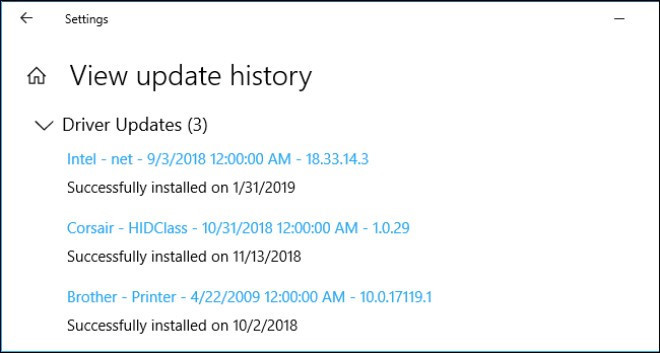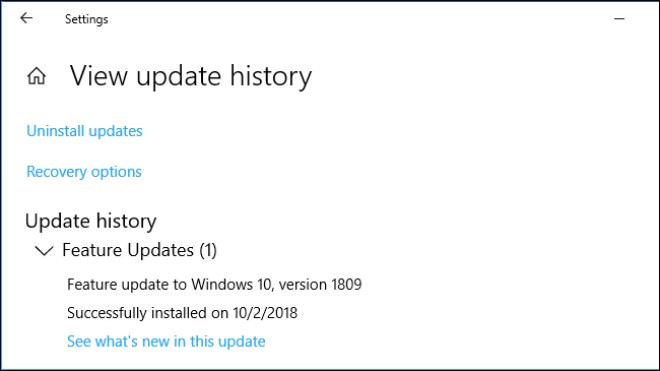Windows 10 update continuously, why?
For Windows 10 users, having to receive the software update notification has become familiar. The update process usually takes place automatically in the background, but most users do not know what Windows installs, when it will happen and why it must be updated regularly.
Regularly check for updates
Maybe you don't know, Windows 10 automatically conducts checking for updates every day, this process takes place in the background. It will automatically download and install if any updates are detected. However, users can adjust this test schedule.

To check for updates on Windows, users can click on Check for updates.
Updated several times a day
Windows Defender (or Windows Security) is a real-time antivirus tool built into Windows 10 to protect your PC. Windows Defender runs automatically in the background. When you install another antivirus software, Windows will allow the software to work and shut down Windows Defender.
To be able to react quickly to the latest malicious code and protect your PC in the best way, Windows Defender needs to be updated regularly. These are small updates, which happen very quickly so Windows does not require a system reboot. It even doesn't send updates to users. The only way to know these updates is to open the update history by going to Settings -> selecting Update & Security -> selecting Windows Update -> choosing View Update History -> selecting Definition Updates.
Update the hardware driver
Hardware drivers are 'bridges' between hardware and software, helping devices like audio, Wi-Fi, graphics, printers and other PC components work. Sometimes to fix bugs or update new developments, hardware manufacturers will release new versions of drivers. Meanwhile, hardware driver updates will be provided to the PC via Windows Update.

Updating the hardware driver makes hardware accessories better compatible with the software.
Depending on the driver, when Windows update may restart or not. For the PC driver update history, you can view the Driver Updates section of the search history.
Microsoft's monthly major update package
Every month, Microsoft releases a monthly update (or Patch Tuesday). This is an important update containing new security patches and security patches released earlier. To check this update package, you can check it by visiting the settings section and clicking the Check for Updates button.
When upgrading to this update, the computer will restart.
Emergency update when there is a gap
When a vulnerability appears, Microsoft will release a folding update that differs from its normal schedule to fix the problem immediately. This update will also require the system to restart.
Large feature updates every 6 months
Every 6 months, Microsoft will release major updates for Windows 10. This update includes many new and improved features. For example, in the near future Microsoft will release an April update with a new default wallpaper interface, improve the Start menu, and support Windows to run faster.

Major feature updates will be released every 6 months.
However, Microsoft is not always' on time 'because they want to provide the best updates for users' hardware. Currently, many Windows computers still do not have the update in October 101018.
These major updates take a lot of time to install and they will require restarting the computer system.
Users can control Windows updates
Windows 10 automatically updates but you can prevent them from doing this during certain hours of the day by visiting Update & Security -> selecting Windows Update, clicking Change Active Hours under Update Settings to change operating hours.
For example: If you regularly use the computer from 18:00 to 22:00, you can mark this as the operating time frame so that Windows 10 will not install the update during that time.
You should read it
- How to fix 'Pause Windows Updates' option not available in Windows 11/10
- Update Windows software
- Microsoft begins to impose a 'expiry date' for Windows updates
- How to pause updates on Windows 11
- Errors on the latest Windows 10 updates and how to fix them (updated continuously)
- How to turn off Windows 7, Windows 8 / 8.1 updates
- Do you need to install all Windows updates?
- Fix Error not downloading or installing updates from Windows Update
May be interested
- How to download Windows 10 Anniversary Update update?
 microsoft has just released an update of windows 10 anniversary update with many improvements and new features. in this update (update) you will see a lot of changes. from windows ink stylus support to extension support on microsoft edge browser, start menu and cortana also improved significantly.
microsoft has just released an update of windows 10 anniversary update with many improvements and new features. in this update (update) you will see a lot of changes. from windows ink stylus support to extension support on microsoft edge browser, start menu and cortana also improved significantly. - 3 ways to update Windows 10 to the latest update 2023
 there are usually 3 ways to update windows 10: using update assistant, media creation tool and windows update. tipsmake.com.com will guide you to update windows 10 in detail using all 3 methods.
there are usually 3 ways to update windows 10: using update assistant, media creation tool and windows update. tipsmake.com.com will guide you to update windows 10 in detail using all 3 methods. - Steps to turn off Windows 11 Update, How to stop updating Windows 11
 microsoft regularly releases updates to patch bugs for its operating system as well as its products and services. windows 11 is also not an exception to this policy, so it will be regularly updated with patches.
microsoft regularly releases updates to patch bugs for its operating system as well as its products and services. windows 11 is also not an exception to this policy, so it will be regularly updated with patches. - How to change, prolong the delay of updating on Windows 10?
 on windows 10 profesional, enterprise and education versions are allowed to postpone updates (update), so users will not have to download the update for a while. you can use local group policy to set a delay time other than the default time.
on windows 10 profesional, enterprise and education versions are allowed to postpone updates (update), so users will not have to download the update for a while. you can use local group policy to set a delay time other than the default time. - Turn off driver update on Windows Update Windows 10
 on recently released versions of windows 10 build 14328 microsoft has added some new options. users can prevent windows 10 from updating drivers. by default, windows 10 automatically installs drivers from windows update when available.
on recently released versions of windows 10 build 14328 microsoft has added some new options. users can prevent windows 10 from updating drivers. by default, windows 10 automatically installs drivers from windows update when available. - How to fix Windows Update error 0xC1900101 - 0x4000D
 update error 0xc1900101 - 0x4000d sometimes appears when users try to install the latest updates on their computers. it usually happens when installing update 22h2 and force reverting the system to windows 10.
update error 0xc1900101 - 0x4000d sometimes appears when users try to install the latest updates on their computers. it usually happens when installing update 22h2 and force reverting the system to windows 10. - Should I plug in the laptop charger continuously?
 many people use laptops often have the habit of plugging in the charger constantly to use as a tree computer. however, is it something to do or not, let's find the answer in the following article.
many people use laptops often have the habit of plugging in the charger constantly to use as a tree computer. however, is it something to do or not, let's find the answer in the following article. - What to do when Windows Update crashes 0% on Windows 7/8/10?
 a windows update error crashes is one of the most common problems windows users face. if you are using windows 7/8/10 and during the update process you are notified that the error cannot be updated, or the error is updating, it will be suspended 0%, then you can apply the solution in the article below. here of network administrator to fix the error.
a windows update error crashes is one of the most common problems windows users face. if you are using windows 7/8/10 and during the update process you are notified that the error cannot be updated, or the error is updating, it will be suspended 0%, then you can apply the solution in the article below. here of network administrator to fix the error. - How to fix some errors when updating Windows 10
 besides the exciting new features, the windows 10 update also has some problems during and after installing the software. read this article to learn how to fix some of the most common problems of this update.
besides the exciting new features, the windows 10 update also has some problems during and after installing the software. read this article to learn how to fix some of the most common problems of this update. - Some Microsoft 365 apps may stop working completely if users don't update to Windows 11
 recently, microsoft has been continuously posting articles on the company's official blog urging users to upgrade to windows 11 as the end of support for windows 10 is approaching.
recently, microsoft has been continuously posting articles on the company's official blog urging users to upgrade to windows 11 as the end of support for windows 10 is approaching.










 Gorgeous concept invitations of Google Play and Google Music according to Material Design 2 design
Gorgeous concept invitations of Google Play and Google Music according to Material Design 2 design Cloudflare launches integrated VPN service in app 1.1.1.1, accelerating faster and safer
Cloudflare launches integrated VPN service in app 1.1.1.1, accelerating faster and safer What is iSIM? Will it replace traditional SIM cards in the future?
What is iSIM? Will it replace traditional SIM cards in the future? Apple fixes the blocking problem that iPhone Lock uses as an international machine without SIM transplant
Apple fixes the blocking problem that iPhone Lock uses as an international machine without SIM transplant Google+ is officially killed, starting to delete user accounts
Google+ is officially killed, starting to delete user accounts Huawei P30 and P30 Pro launched in Vietnam, priced between 17 and 23 million VND
Huawei P30 and P30 Pro launched in Vietnam, priced between 17 and 23 million VND